

World history was made by spices. The clamour for these now-uniquitous ingredients in Europe led to the quest for the elusive sea passage to the Indies, with everybody from the Portuguese to the Venetians throwing their hats into the ring to find a way to get their hands on the precious pepper, cloves, cinnamon and nutmeg that grew in the East. It was the demand for spices that fuelled colonialism.
While these condiments may not overturn kingdoms and be the incentive for expensive voyages to far-flung corners of the globe any longer, they are still important. Some, like saffron or vanilla, are precious commodities even in monetary terms; but nearly all—even the humble coriander, cumin or turmeric, so casually tossed into our food and drink—have a value that cannot be denied. Take the spice away from food, and it loses more than just flavour: it loses its zing.
Much-acclaimed chef Vikas Khanna sets out to examine this world in Ceremony of Aromas. Beginning with black pepper and going all the way to vanilla, the spices in this book are arranged in alphabetical order, each chapter devoted to one spice. Each chapter begins with a one-page introduction to the herb. How it’s processed, used and, wherever pertinent, something about its significance in history, literature, etc. This aspect of the book, however, is a little dry, and not particularly well-written.
In contrast, for instance, to Marryam H Reshii’s engrossing 2017 book, The Flavour of Spice, the information here is scanty, superficial and not intriguing. The text often skips jerkily from one topic to another, sometimes repeating facts and, at other times, providing only desultory and mundane information. Khanna’s deeply personal introduction to the book itself (in which he talks of his childhood fascination with spices, so much so that it got him dubbed the masala chor at home) is missing from these sections: these are impersonal, with nothing of the chef’s own insights.
On the other hand, the eye-catching introductory photograph for each chapter, showing the progression across the stages of a spice—from shoot through green leaf to dried leaf; from bud to flower to seedpod, for instance—is creatively done and offers an interesting approach to the ingredient in question.
While the introductions may not be particularly riveting, the recipes that follow make up for that lack. Each chapter consists of some seven or eight recipes, proceeding in order from appetisers through main courses, drinks and even desserts. Each is accompanied by a full-page, well-styled photograph, and is a good reflection of Khanna’s status as a leading chef of a global table. The cuisines range from East Asian to Mediterranean, Indian to modern fusion.
For those who might expect a book on spices, by an Indian chef at that, to be heavy on local recipes, Ceremony of Aromas can be an eye-opener. Yes, there are familiar items here, but they are relatively few, and they often come with an unexpected twist. The beetroot poriyal has an addition of cherry tomatoes; the strawberry kulfi—already avant garde—comes with a surprising spice element included in the mix: crushed coriander seeds.
These surprises, unusual but oddly appropriate, appear in many of the other, non-Indian, dishes as well. A yuzu and maple pan-seared chicken, for instance, has the oil infused with cloves. A frittata, besides the rather unique presence of ripe peaches, has tart mango powder (aamchoor, as it’s known in Hindi) added to it. A rice pudding scented with star anise also includes apricots and chickpeas.
What really stands out in these recipes is the way Khanna melds creativity with simplicity. These are not the sort of dishes that break the bank and are best suited to a kitchen brigade with a slew of fancy equipment at its disposal. As the author mentions in one recipe, “I enjoy entertaining when I can get maximum flavour with minimum effort”, and this is the credo that seems to govern most of these recipes: not too many ingredients, no fancy cooking, but solid flavours and good food. True, some ingredients (Chioggia beets, sandalwood extract, pineberries, et al) may not be easily available for Indian readers, but on the whole, this is a collection of recipes that would appeal to any food enthusiast across the world. It’s doable, it’s different, and it is, all said and done, a worthy tribute to the spices that have shaped our world.